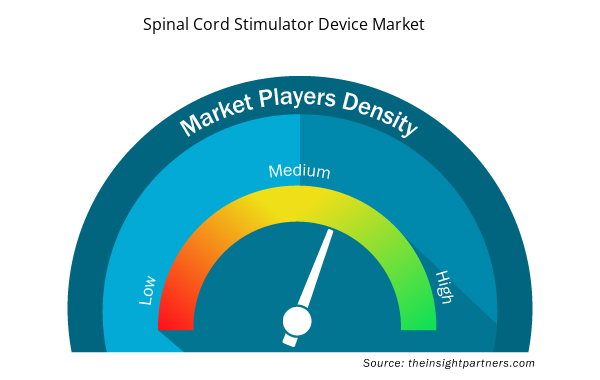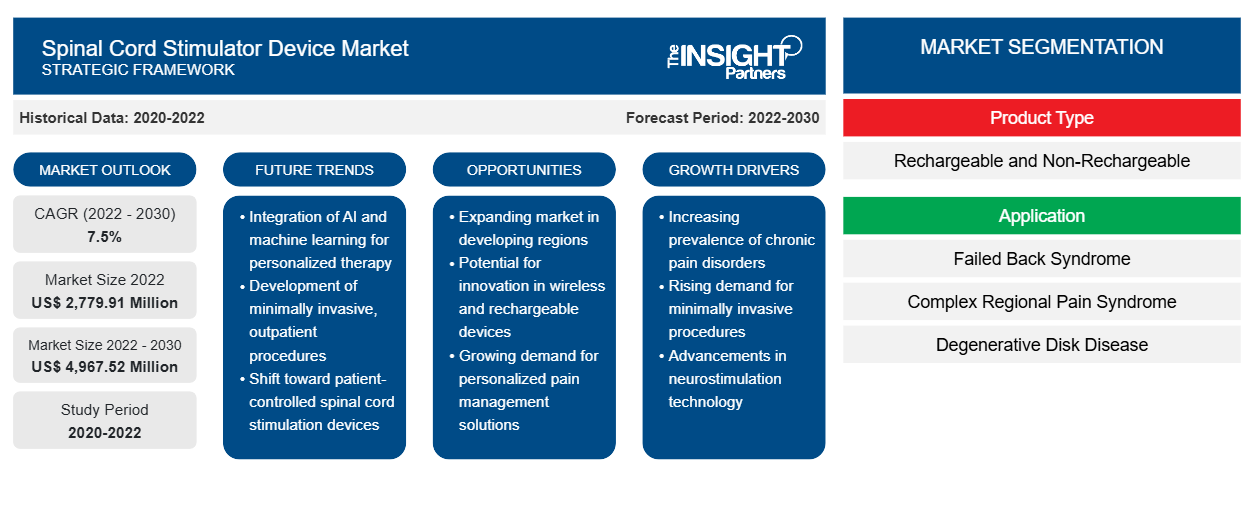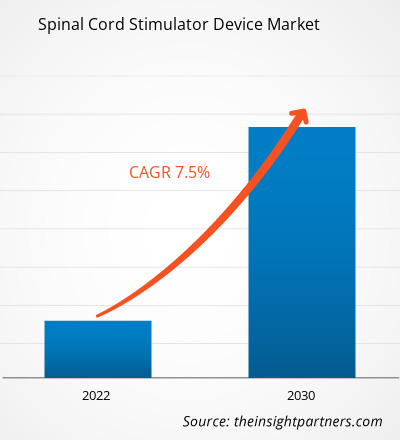[研究报告] 脊髓刺激器设备市场预计将从 2022 年的 27.7991 亿美元增长到 2030 年的 49.6752 亿美元;预计 2022 年至 2030 年的复合年增长率为 7.5%。
市场洞察和分析师观点:
脊髓刺激装置是一种植入式装置,它通过将低水平电信号直接传输到脊髓来缓解疼痛。刺激器主要用于非手术疼痛治疗无法提供足够缓解后。此外,该装置可以改善整体生活质量和睡眠。由于它通常与其他疼痛管理治疗一起开处方,因此可以有效抑制对止痛药的需求。随着脊髓损伤 (SCI) 数量的增加和创新治疗方法的出现,脊髓刺激器装置的市场规模正在扩大。
增长动力和挑战:
根据美国国家医学图书馆 (NLM) 的数据,全球每年有近 250,000-500,000 名患者遭受脊髓损伤 (SCI)。根据英国脊髓损伤研究、康复和再融合协会 (Aspire) 发布的一份报告,英国每年约有 2,500 人被诊断出患有 SCI。目前,英国约有 50,000 人患有此类损伤。美国国家脊髓损伤统计中心 (NSCISC) 估计,美国约有 320,000 人患有创伤性 SCI。根据美国国立卫生研究院 (NIH) 的报告,病例数量的增加归因于越野摩托车和摩托车比赛正在成为全球最受欢迎的体育活动。
此外,这些伤害在老年人口中很常见。根据世界银行 2022 年发展指标收集提供的数据,德国 22.41% 的人口年龄在 65 岁以上。MDPI 发表的一篇文章提到,创伤性脊髓损伤的发病率约为每百万居民 500 人,全球发病率飙升至每百万 13 人。
脊髓损伤对受伤患者及其家人的生活产生了重大影响。脊髓损伤的发病率不断上升,患者在医院接受相应的治疗,因此每年至少有一名患者再次入院。这是因为脊髓损伤不能立即治疗。再次入院的原因包括呼吸道和泌尿道感染以及摩托车运动期间发生的骨折。随着脊髓损伤的增多以及提供康复计划的治疗中心基础设施的完善,专科或康复中心对脊髓刺激装置的需求激增,推动了脊髓刺激装置的发展。
定制此报告以满足您的需求
您可以免费定制任何报告,包括本报告的部分内容、国家级分析、Excel 数据包,以及为初创企业和大学提供优惠和折扣
- 获取此报告的关键市场趋势。这个免费样品将包括数据分析,从市场趋势到估计和预测。
报告细分和范围:
脊髓刺激器设备市场根据产品类型、应用、最终用户和地理位置进行划分。根据产品类型,脊髓刺激器设备市场分为可充电和不可充电。脊髓刺激器设备市场根据应用细分为背痛综合症、复杂性局部疼痛综合症、退行性椎间盘疾病等。就最终用户而言,市场分为医院、门诊手术中心和其他。根据地理位置,脊髓刺激器设备市场细分为北美(美国、加拿大和墨西哥)、欧洲(英国、德国、法国、意大利、西班牙、俄罗斯和欧洲其他地区)、亚太地区(中国、日本、印度、韩国、澳大利亚、东南亚和亚太其他地区)、中东和非洲(阿联酋、沙特阿拉伯、南非和中东和非洲其他地区)以及南美洲和中美洲(巴西、阿根廷和南美洲和中美洲其他地区)。
节段分析:
脊髓刺激器设备市场根据应用细分为腰椎间盘功能衰竭综合征、复杂区域性疼痛综合征、退行性椎间盘疾病等。复杂区域性疼痛综合征细分市场在 2022 年占据了最大的市场份额。预计在 2022-2030 年期间将实现最高的复合年增长率。复杂区域性疼痛综合征 (CRPS) 涉及因受伤或其他医疗事件(例如手术、创伤、中风和心脏病发作)而发生的长期疼痛和炎症。CRPS 可能发生在身体的任何部位,通常影响手臂、腿、手或脚。它更有可能发生在任何年龄的任何人身上,炎症在 40 年后达到顶峰。大多数 CRPS 病例是由受损或功能不正常的小外周 C 纤维神经纤维引起的,这些神经纤维将疼痛信号传递到大脑。CRPS 通常无法诊断,因为会形成微小的血栓,有时会阻塞流向神经的血液并使其受伤。
脊髓刺激器设备市场(按应用)——2022 年和 2030 年
区域分析:
根据地域,脊髓刺激器设备市场分为北美、欧洲、亚太地区、中东和非洲以及南美和中美洲。北美是全球脊髓刺激器设备市场增长的最大贡献者。预计从 2022 年到 2030 年,亚太地区将在脊髓刺激器设备市场中创下最高复合年增长率。脊髓损伤发病率的持续上升与该市场的增长有关。目前,脊髓损伤是北美国家的主要健康负担。根据 Spinal Cord Inc. 的数据,美国每年约有 18,000 人遭受此类伤害。
脊髓刺激器设备市场区域洞察
Insight Partners 的分析师已详尽解释了预测期内影响脊髓刺激器设备市场的区域趋势和因素。本节还讨论了北美、欧洲、亚太地区、中东和非洲以及南美和中美洲的脊髓刺激器设备市场细分和地理位置。

- 获取脊髓刺激器设备市场的区域特定数据
脊髓刺激器设备市场报告范围
| 报告属性 | 细节 |
|---|---|
| 2022 年市场规模 | 27.7991亿美元 |
| 2030 年市场规模 | 49.6752亿美元 |
| 全球复合年增长率(2022 - 2030 年) | 7.5% |
| 史料 | 2020-2022 |
| 预测期 | 2022-2030 |
| 涵盖的领域 | 按产品类型
|
| 覆盖地区和国家 | 北美
|
| 市场领导者和主要公司简介 |
|
市场参与者密度:了解其对商业动态的影响
脊髓刺激器设备市场正在快速增长,这得益于终端用户需求的不断增长,而这些需求又源于消费者偏好的不断变化、技术进步以及对产品优势的认识不断提高等因素。随着需求的增加,企业正在扩大其产品范围,进行创新以满足消费者的需求,并利用新兴趋势,从而进一步推动市场增长。
市场参与者密度是指在特定市场或行业内运营的企业或公司的分布情况。它表明相对于给定市场空间的规模或总市场价值,有多少竞争对手(市场参与者)存在于该市场空间中。
在脊髓刺激器设备市场运营的主要公司有:
- 波士顿科学公司
- 内夫罗公司
- 雅培实验室
- Cirtec 医疗公司
- 美敦力公司
免责声明:上面列出的公司没有按照任何特定顺序排列。

- 获取脊髓刺激器设备市场顶级关键参与者概述
行业发展和未来机遇:
脊髓刺激器设备市场主要参与者的关键举措如下:
- 2022 年 8 月,雅培实验室的 Proclaim Plus SCS 系统获得美国 FDA 批准,用于治疗慢性疼痛。BurstDR 刺激技术使该设备能够提供卓越的疼痛缓解。它提供 FlexBurst360 疗法,可覆盖躯干和四肢的疼痛;该设备可以根据患者不断变化的治疗需求进行编程。
- 2022 年 12 月,雅培实验室的 Eterna 脊髓刺激 (SCS) 系统将上市,用于治疗慢性疼痛。雅培的低剂量 BurstDR 刺激是一种获得专利的低剂量 SCS 波形技术,具有最丰富的临床证据,已获得 FDA 批准。此外,事实证明,与基于传统波形技术的方法相比,该技术可帮助减轻 23% 的疼痛。
竞争格局和重点公司:
脊髓刺激器设备市场的一些知名参与者包括波士顿科学公司、Nevro 公司、雅培实验室、Cirtec Medical 公司、美敦力公司、Biotronik SE & Co KG、Curonix LLC、Nalu Medical, Inc. 和 Synapse Biomedical Inc. 这些公司专注于新产品的推出和地域扩张,以满足全球消费者的需求并增加其专业产品组合的产品范围。他们的全球业务使他们能够服务于庞大的客户群,从而促进市场扩张。
- 历史分析(2 年)、基准年、预测(7 年)及复合年增长率
- PEST 和 SWOT 分析
- 市场规模价值/数量 - 全球、区域、国家
- 行业和竞争格局
- Excel 数据集



Report Coverage
Revenue forecast, Company Analysis, Industry landscape, Growth factors, and Trends

Segment Covered
This text is related
to segments covered.

Regional Scope
North America, Europe, Asia Pacific, Middle East & Africa, South & Central America

Country Scope
This text is related
to country scope.
常见问题
Based on product type, the spinal cord stimulator device market is bifurcated into rechargeable and non-rechargeable. The rechargeable segment held a larger market share in 2022 and is expected to record a significant CAGR during 2022–2030. In terms of end users, the spinal cord stimulator device market is categorized into hospitals, ambulatory surgery centers, and others. The hospital segment held the largest share of the market in 2022 and is anticipated to register the highest CAGR during 2022–2030.
Based on geography, the spinal cord stimulator device market is segmented into North America (the US, Canada, and Mexico), Europe (the UK, Germany, France, Italy, Spain, and the Rest of Europe), Asia Pacific (China, Japan, India, South Korea, Australia, and the Rest of Asia Pacific), the Middle East & Africa (the UAE, Saudi Arabia, South Africa, and Rest of the Middle East & Africa), and South & Central America (Brazil, Argentina, and the Rest of South & Central America). North America is the largest contributor to the growth of the global spinal cord stimulator device market. Asia Pacific is expected to register the highest CAGR in the spinal cord stimulator device market from 2022 to 2030.
The spinal cord stimulator device market majorly consists of players such as Boston Scientific Corp, Nevro Corp, Abbott Laboratories, Cirtec Medical Corp, Medtronic Plc, Biotronik SE & Co KG, Curonix LLC, Nalu Medical Inc, and Synapse Biomedical Inc
The increasing cases of spinal cord injuries and strategic initiatives by companies bolster the spinal cord stimulator devices market size. However, the high cost associated with spinal cord stimulator devices hinders the market growth.
A spinal cord stimulation device is an implanted device that relieves pain by transmitting low-level electrical signals directly into the spinal cord. The stimulator is mostly used after nonsurgical pain treatments fail to provide sufficient relief. Additionally, the device can improve the overall quality of life and sleep. As it is typically prescribed along with other pain management treatments, it effectively suppresses the need for pain medicines. The spinal cord stimulator device market size is expanding with the rising number of spinal cord injuries (SCIs) and the availability of innovative treatments.
Trends and growth analysis reports related to Life Sciences : READ MORE..
The List of Companies - Spinal Cord Stimulator Device Market
- Boston Scientific Corp
- Nevro Corp
- Abbott Laboratories
- Cirtec Medical Corp
- Medtronic Plc
- Biotronik SE & Co KG
- Curonix LLC
- Nalu Medical, Inc.
- Synapse Biomedical Inc
The Insight Partners performs research in 4 major stages: Data Collection & Secondary Research, Primary Research, Data Analysis and Data Triangulation & Final Review.
- Data Collection and Secondary Research:
As a market research and consulting firm operating from a decade, we have published and advised several client across the globe. First step for any study will start with an assessment of currently available data and insights from existing reports. Further, historical and current market information is collected from Investor Presentations, Annual Reports, SEC Filings, etc., and other information related to company’s performance and market positioning are gathered from Paid Databases (Factiva, Hoovers, and Reuters) and various other publications available in public domain.
Several associations trade associates, technical forums, institutes, societies and organization are accessed to gain technical as well as market related insights through their publications such as research papers, blogs and press releases related to the studies are referred to get cues about the market. Further, white papers, journals, magazines, and other news articles published in last 3 years are scrutinized and analyzed to understand the current market trends.
- Primary Research:
The primarily interview analysis comprise of data obtained from industry participants interview and answers to survey questions gathered by in-house primary team.
For primary research, interviews are conducted with industry experts/CEOs/Marketing Managers/VPs/Subject Matter Experts from both demand and supply side to get a 360-degree view of the market. The primary team conducts several interviews based on the complexity of the markets to understand the various market trends and dynamics which makes research more credible and precise.
A typical research interview fulfils the following functions:
- Provides first-hand information on the market size, market trends, growth trends, competitive landscape, and outlook
- Validates and strengthens in-house secondary research findings
- Develops the analysis team’s expertise and market understanding
Primary research involves email interactions and telephone interviews for each market, category, segment, and sub-segment across geographies. The participants who typically take part in such a process include, but are not limited to:
- Industry participants: VPs, business development managers, market intelligence managers and national sales managers
- Outside experts: Valuation experts, research analysts and key opinion leaders specializing in the electronics and semiconductor industry.
Below is the breakup of our primary respondents by company, designation, and region:

Once we receive the confirmation from primary research sources or primary respondents, we finalize the base year market estimation and forecast the data as per the macroeconomic and microeconomic factors assessed during data collection.
- Data Analysis:
Once data is validated through both secondary as well as primary respondents, we finalize the market estimations by hypothesis formulation and factor analysis at regional and country level.
- Macro-Economic Factor Analysis:
We analyse macroeconomic indicators such the gross domestic product (GDP), increase in the demand for goods and services across industries, technological advancement, regional economic growth, governmental policies, the influence of COVID-19, PEST analysis, and other aspects. This analysis aids in setting benchmarks for various nations/regions and approximating market splits. Additionally, the general trend of the aforementioned components aid in determining the market's development possibilities.
- Country Level Data:
Various factors that are especially aligned to the country are taken into account to determine the market size for a certain area and country, including the presence of vendors, such as headquarters and offices, the country's GDP, demand patterns, and industry growth. To comprehend the market dynamics for the nation, a number of growth variables, inhibitors, application areas, and current market trends are researched. The aforementioned elements aid in determining the country's overall market's growth potential.
- Company Profile:
The “Table of Contents” is formulated by listing and analyzing more than 25 - 30 companies operating in the market ecosystem across geographies. However, we profile only 10 companies as a standard practice in our syndicate reports. These 10 companies comprise leading, emerging, and regional players. Nonetheless, our analysis is not restricted to the 10 listed companies, we also analyze other companies present in the market to develop a holistic view and understand the prevailing trends. The “Company Profiles” section in the report covers key facts, business description, products & services, financial information, SWOT analysis, and key developments. The financial information presented is extracted from the annual reports and official documents of the publicly listed companies. Upon collecting the information for the sections of respective companies, we verify them via various primary sources and then compile the data in respective company profiles. The company level information helps us in deriving the base number as well as in forecasting the market size.
- Developing Base Number:
Aggregation of sales statistics (2020-2022) and macro-economic factor, and other secondary and primary research insights are utilized to arrive at base number and related market shares for 2022. The data gaps are identified in this step and relevant market data is analyzed, collected from paid primary interviews or databases. On finalizing the base year market size, forecasts are developed on the basis of macro-economic, industry and market growth factors and company level analysis.
- Data Triangulation and Final Review:
The market findings and base year market size calculations are validated from supply as well as demand side. Demand side validations are based on macro-economic factor analysis and benchmarks for respective regions and countries. In case of supply side validations, revenues of major companies are estimated (in case not available) based on industry benchmark, approximate number of employees, product portfolio, and primary interviews revenues are gathered. Further revenue from target product/service segment is assessed to avoid overshooting of market statistics. In case of heavy deviations between supply and demand side values, all thes steps are repeated to achieve synchronization.
We follow an iterative model, wherein we share our research findings with Subject Matter Experts (SME’s) and Key Opinion Leaders (KOLs) until consensus view of the market is not formulated – this model negates any drastic deviation in the opinions of experts. Only validated and universally acceptable research findings are quoted in our reports.
We have important check points that we use to validate our research findings – which we call – data triangulation, where we validate the information, we generate from secondary sources with primary interviews and then we re-validate with our internal data bases and Subject matter experts. This comprehensive model enables us to deliver high quality, reliable data in shortest possible time.


 获取此报告的免费样本
获取此报告的免费样本